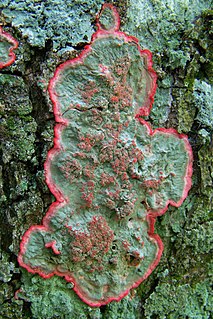Symbionts

- "Lichens are fungi that have discovered agriculture" - Trevor Goward [8]
Living as a symbiont in a lichen appears to be a successful way for a fungus to derive essential nutrients, as about 20% of all fungal species have acquired this mode of life. The fungal partner may be an Ascomycete or Basidiomycete. [9] Common algal partners are Trebouxia , Pseudotrebouxia , or Myrmecia . Common cyanobacterium partners include are Nostoc [1] or Scytonema . [9]
The largest number of lichenized fungi occur in the Ascomycota, with about 40% of species forming such an association. [10] Some of these lichenized fungi occur in orders with nonlichenized fungi that live as saprotrophs or plant parasites (for example, the Leotiales, Dothideales, and Pezizales). Other lichen fungi occur in only five orders in which all members are engaged in this habit (Orders Graphidales, Gyalectales, Peltigerales, Pertusariales, and Teloschistales). Lichenized and nonlichenized fungi can even be found in the same genus or species.[ citation needed ] Overall, about 98% of lichens have an ascomycetous mycobiont. Next to the Ascomycota, the largest number of lichenized fungi occur in the unassigned fungi imperfecti. Comparatively few Basidiomycetes are lichenized, but these include agarics, such as species of Lichenomphalia , clavarioid fungi, such as species of Multiclavula , and corticioid fungi, such as species of Dictyonema .
The autotrophic symbionts occurring in lichens are a wide variety of simple, photosynthetic organisms commonly and traditionally known as algae. These symbionts include both prokaryotic and eukaryotic organisms. Approximately 100 species of photosynthetic partners from 40 genera and five distinct classes (prokaryotic: Cyanophyceae; eukaryotic: Trebouxiophyceae, Phaeophyceae, Chlorophyceae) have been found to associate with the lichen-forming fungi. [11] The prokaryotes belong to the Cyanobacteria, whose representatives are often called bluegreen algae. The bluegreen algae occur as symbionts in about 8% of the known lichens. The most commonly occurring genus is Nostoc . [12] The majority of the lichens contain eukaryotic autotrophs belonging to the Chlorophyta (green algae) or to the Xanthophyta (yellow-green algae). About 90% of all known lichens have a green alga as a symbiont, and among these, Trebouxia is the most common genus, occurring in about 40% of all lichens. The second most commonly represented green alga genus is Trentepohlia . Overall, about 100 species are known to occur as autotrophs in lichens. All the algae are probably able to exist independently in nature as well as in the lichen. [12]
A particular fungus species and algal species are not necessarily always associated together in a lichen. One fungus, for example, can form lichens with a variety of different algae. The thalli produced by a given fungal symbiont with its differing partners will be similar, and the secondary metabolites identical, indicating that the fungus has the dominant role in determining the morphology of the lichen. Further, the same algal species can occur in association with different fungal partners. Lichens are known in which there is one fungus associated with two or even three algal species. Rarely, the reverse can occur, and two or more fungal species can interact to form the same lichen. [12]
Both the lichen and the fungus partner bear the same scientific name, and the lichens are being integrated into the classification schemes for fungi. The alga bears its own scientific name, which bears no relationship to that of the lichen or fungi. [10]
Fungus component
Depending on context, the entire lichen, or just the fungus that is part of the lichen. Both the lichen and the fungus that is a part of the lichen are currently (2014) given the same species name, which creates an ambiguity. An example of when "lichenized fungus" refers to just the fungus is when the fungus is grown in culture without a phycobiont. An example where "lichenized fungus" refers to the entire lichen is in a list of classified lichens.
Some fungi can only be found living on lichens (obligate parasites), but are not considered part of the lichen. These are referred to as lichenolous fungi.
Photosynthetic component
The photosynthetic component of a lichen is called the photobiont or phycobiont . [13] Sometimes the photobiont is a green algae (chlorophyta), sometimes a blue-green aglae (cyanobacteria, not really an algae), and sometimes both. The layer of tissue containing the cells of the photobiont is called the "photobiontic layer". [13]
"Clorococcoid" means a green algae (Chlorophyta) that has single cells that are globose, which is common in lichens. [14] This was once classified in the order Chlorococcales, which you may find stated in older literature, but new DNA data shows many independent lines of evolution exist among this formerly large taxonomic group. Chlorococcales is now a relatively small order and may no longer include any lichen photobionts. Trebouxia, once included here, is now considered to be in a separate class, Trebouxiophyceae. "trebouxioid" refers to members of this class or algae resembling them.
" Trebouxioid " means a clorococcoid green algae photobiont is in the genus Trebouxia , or resembles a member of that genus, and is therefore presumably a member of the class Trebouxiophyceae. [13]
Cyanolichens
A cyanolichen is a lichen with a cyanobacteria as its main photosynthetic component (photobiont). [14] Many cyanolichens are small and black, and have limestone as the substrate. Another cyanolichen group, the jelly lichens ( e.g., from the genera Collema or Leptogium ) are large and foliose (e.g., species of Peltigera , Lobaria , and Degelia . These lichen species are grey-blue, especially when dampend or wet. Many of these characterize the Lobarion communities of higher rainfall areas in western Britain, e.g., in the Celtic Rainforest.










